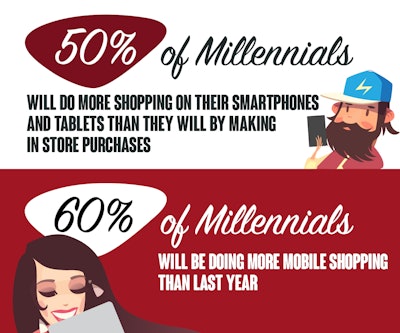
The next six weeks will be critical ones for the e-commerce industry, as we are just days away from Black Friday and Cyber Monday, the kick-off to the most important shopping season of the year for retailers. Many were hard at work for months preparing for this peak period. This is also when Dynatrace conducts its annual survey on mobile holiday shopping to help give the retail industry a forewarning of what is ahead. The findings this year are clear: Millennials are changing holiday shopping forever as their demands for high-quality digital performance go through the roof.
We call the trends we’re seeing “Coming Back to the Digital Future.” Why? Because we can see the future of retail by looking at what mobile shoppers ages 18 to 34 are asking for now. And while their expectations and hopes for great shopping experiences is nothing new (it is exactly what their parents wanted years ago), they are adding a digital twist. Rather than in-store personal customer service, they are focused on the digital experiences they receive on their smartphones and tablets.
In October, we had Harris Poll survey more than 5,000 smartphone and tablet users in the United States, United Kingdom, France, Germany and Australia. Here’s a closer look at the survey findings:
Mobile shopping will shatter records again this year.
Smartphone and tablet shopping will be a dominant factor across web, mobile web and mobile applications for holiday shopping this year. In fact, 60 percent of Millennials and 42 percent of all survey participants will do more shopping on their devices this year, setting the stage for yet another historic mobile shopping season.
Even more significant is that 50 percent of Millennials will do more holiday shopping with their mobile devices than in stores. And if you’re a retailer targeting UK Millennials, watch out, because 60 percent of these customers will do more purchasing with their smartphones and/or tablets than in stores.
In-store shopping is now also digital shopping.
Brick-and-mortar shopping is more integrated than ever in buyers’ omnichannel journeys. Mobile devices will continue to grow in use by a large majority of Millennials as they roam the aisles—62 percent say they will use their smartphones and/or tablets when they are in aisles to compare prices, read product reviews and download coupons. And nearly 40 percent of them won’t even get in a physical line to make purchases; they’ll be using their smartphones and tablets to buy. Millennials in the U.S. are leading the charge here, with 71 percent marching into stores with their devices on and ready.
For retailers, this means connecting in-store and digital experiences at peak performance is a prerequisite for holiday shopping success.
The Price of Poor Digital Performance … Substantial Revenue Losses
Just like years ago when retailers differentiated by delivering great in-store shopping experiences for their parents, Millennials expect immediacy in their digital experiences—and poor performance directly results in lost orders and revenue.
The numbers are crystal clear here. Seventy-five percent of all shoppers and 81 percent of Millennials report that, if a mobile site or mobile app is buggy, slow or prone to crashes, they would abandon it and shop elsewhere. This is definitely a red alert for retailers. Losing eight of every 10 shoppers because a site or app isn’t performing is a high price to pay.
Sure, mobile users know that performance problems exist, in fact, the survey found that 54 percent of Millennials encountered problems with an unresponsive mobile site or mobile app while shopping during the last three months. But they are not forgiving of poor digital performance. Only 68 percent of all holiday shoppers using their smartphones and/or tablets say they would try a mobile site or app one more time if it did not work the first time. That’s an immediate loss of 32 percent of shoppers.
Response time matters as well. Forty-nine percent of Millennials and 47 percent of all shoppers using their smartphones and/or tablets say they would shop elsewhere if a mobile site or app fails to load in 3 seconds or less.
Retailer Reputations Will Be Damaged
More than abandoned carts and short-term losses are at stake when mobile shoppers air their frustrations on social media. Millions of Millennials stand ready to broadcast their disappointment to hundreds of millions of holiday shoppers. Fifty-one percent of all Millennials surveyed (including 59 percent of Australian Millennials) say they are likely to complain on social media about a poor online shopping experience.
This is more than collateral damage; it is a major threat to retailers’ reputations. In today’s digital world, your apps are your brands—and if they deliver poor experiences, the world will hear about it, and your brand and customer loyalty will suffer.
Mobile Apps Are Now an Important Part of Omnichannel Strategies
Millennial habits lead the way into the future and more than half (54 percent) prefer mobile apps to mobile websites. The take-away here is that, beyond including mobile apps in their omnichannel strategies, retailers must ensure they are fine-tuned to deliver flawless customer experiences.
It is commonly understood that mobile app users are a retailers’ most loyal customers. They have gone through the effort of downloading and installing the app, and that comes with expectations. Sixty-two percent of Millennials say that company-specific mobile applications have better user experience and performance.
Retailers need to deliver by providing them with high-quality digital experiences on their native and hybrid mobile apps. Not only are revenue, reputation and sales at stake, so is the ability to interact with them in personalized ways (e.g. through notifications, location-based services and coupons) that will increase their loyalty and purchasing levels in the months and years ahead.
Digital Performance Management Is the Future
The future is here. Mobile is evolving from a primary engagement channel to a primary transactional channel and needs to be a full partner in omnichannel strategies. Part of this digital revolution is the changing behaviors and expectations of customers. Each demands exceptional experiences at their time and place of need, so businesses must deliver outstanding digital experiences every time, at scale and in a multitude of user contexts—or suffer the consequences.
As retailers’ needs to deliver exceptional digital experiences across all touchpoints continues to skyrocket, digital business, development and information technology (IT) teams need to collaborate.
With digital performance management, development, IT operations and business teams can get needed analytics and technical context to better collaborate and focus on business outcomes. With customer experience as the driver, they can focus their efforts to maximize impact. This is the essence of digital performance—seamlessly tracking and analyzing every digital touch, for every customer and delivering actionable insights for business, operations and development based on unified analytics.















